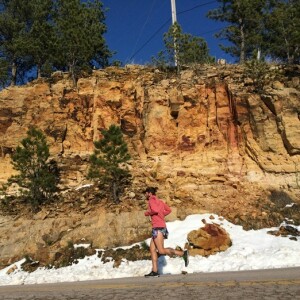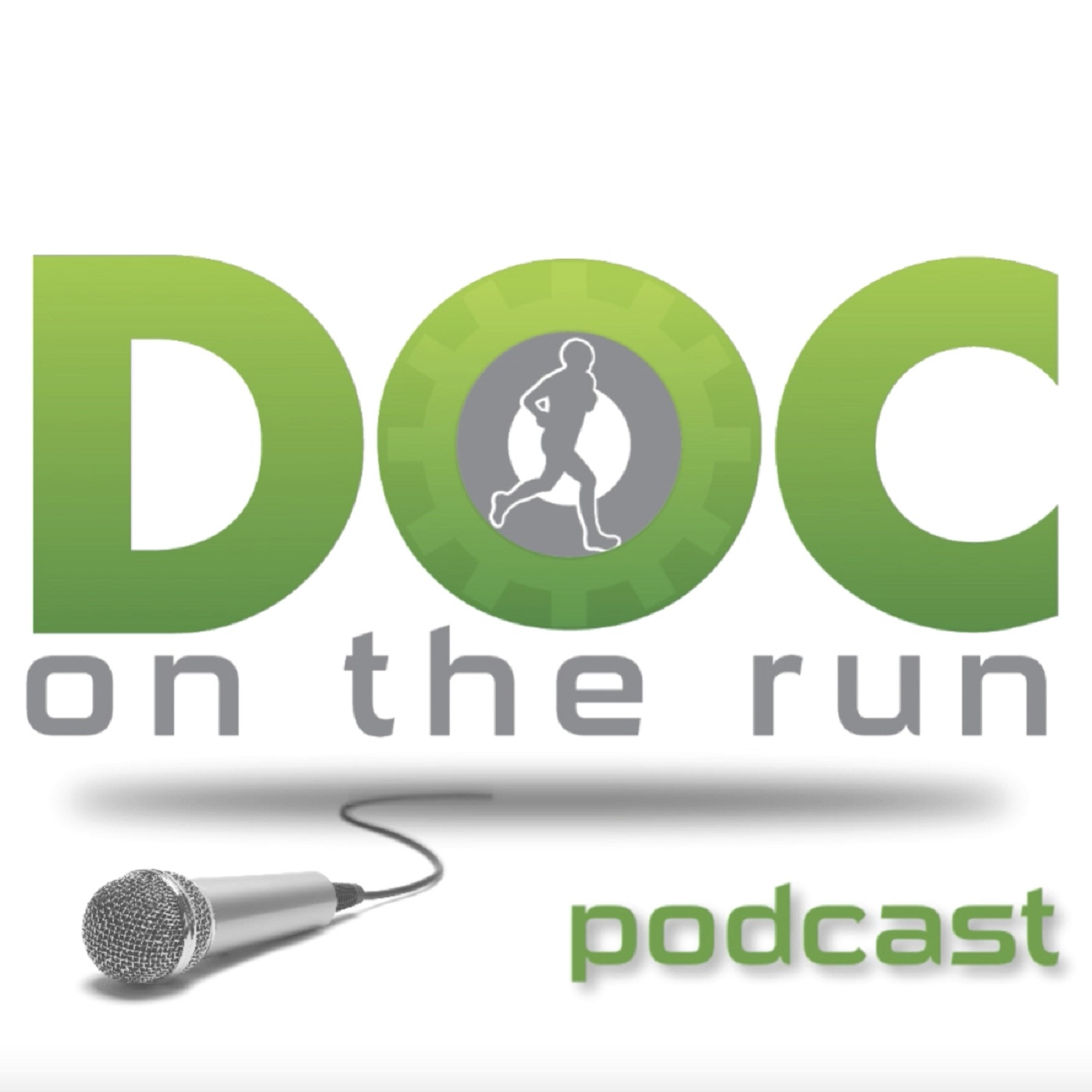Episodes

Wednesday Mar 20, 2024
How dress shoes with long toe box act as a lever to stress plantar plate
Wednesday Mar 20, 2024
Wednesday Mar 20, 2024
I recently did a consultation with a runner who had gotten a plantar plate injury. He had been getting better by using some of the tricks I teach in the Plantar Plate Course For Runners.
He got better, he was protecting it, he reduced the stress and strain on the ligament, and he got back to running. He was doing great.
But then he had a setback when he went to the synagogue. He was dressed up and wearing some fancy dress shoes, and he started to get plantar plate pain again.
Today on the Doc On The Run Podcast, we're talking about how dress shoes with a long toe box can actually work as a lever against your plantar plate.

Monday Mar 18, 2024
Can a Cortisone injection as stop gap for plantar fasciitis in runner
Monday Mar 18, 2024
Monday Mar 18, 2024
I was just at the International Foot & Ankle foundation meeting in Lake Tahoe listening to a lecture given by a Professor of Biomechanics and Podiatric Medicine at Barry University.
He said that a cortisone injection can be used as a "stop gap treatment" in heel pain caused by plantar fasciitis.
The idea is that some runners may need pain relief sooner than would normally be expected. It is true that corticosteroid injections can reduce the inflammation in and around the plantar fascia and quickly reduce pain.
When I had "normal practice" with "normal patients," I used to treat plantar fasciitis with corticosteroid injections pretty much daily.
But I almost never do plantar fascia cortisone injections now.
Can a corticosteroid injection serve as a stop gap for runners with heel pain?
That's what we're talking about today on the Doc On The Run Podcast.

Friday Mar 15, 2024
Worse exercise for plantar plate when building uphill strength
Friday Mar 15, 2024
Friday Mar 15, 2024
I just had a conversation with a runner who has a plantar plate injury.
He got the plantar plate sprain trying to build his uphill running strength in preparation for a trail race.
This is no rookie mistake. He is a longtime ultra marathoner with lots of experience. But he made a common mistake determined runners can make.
Today on the Doc On The Run Podcast, we're talking about one of the worst exercises you can do if you have a plantar plate sprain and you've been trying to build your uphill running strength for a trail race.

Wednesday Mar 13, 2024
How to patch test for tape allergy
Wednesday Mar 13, 2024
Wednesday Mar 13, 2024
Taping is one of the oldest and simplest ways to treat foot pain and injuries to the toes, feet and ankles.
There is a specific way to take your ankles after an ankle sprain so you can start running earlier.
If you have a plantar plate sprain you might try taping the toe to decrease some of the stress and strain on the plantar plate ligament when you run.
If you have a broken toe, buddy-splinting with tape can really help hold the broken bone still so it can hurt less and heal faster.
But if your skin gets irritated, and you are forced to stop using it, the tape can't help you at all.
Today on the Doc On The Run Podcast, we’re talking about how to patch test for tape allergy.

Monday Mar 11, 2024
What is hyperemia in medical imaging of shin splints?
Monday Mar 11, 2024
Monday Mar 11, 2024
I recently saw an elite runner who had what he thought was shin splints. One of the findings on the MRI report was something called "hyperemia."
He asked me:
“What does that mean? Does that mean I have a stress fracture? Does that mean I have shin splints?”
What does hyperemia mean when you see it on an MRI report or an ultrasound report and you have something like shin splints or a tibial stress reaction?
Well, good question and that's what we're talking about today on the Doc On The Run Podcast.

Friday Mar 08, 2024
When is fracture boot really needed with metatarsal stress fracture?
Friday Mar 08, 2024
Friday Mar 08, 2024
I believe the most commonly prescribed and most overprescribed treatment for injured runners is probably a fracture walking boot.
The big question for your doctor is...
Is the fracture walking boot really necessary or not, given my stage of injury recovery?
When is a fracture walking boot really necessary for a metatarsal stress fracture?
Well, that's a great question and that's what we're talking about today on the Doc On The Run Podcast.

Wednesday Mar 06, 2024
Overtraining injuries are caused by weakness
Wednesday Mar 06, 2024
Wednesday Mar 06, 2024
When you get an overtraining injury from running, it's not because you did too much, because you were too strong or too motivated.
You got injured because you were too weak.
You were too weak to sustain the stress applied to that piece of tissue, that one injured piece of tissue that got injured when you did one workout.
That's what really happened.
If you get injured, you have to understand how to correct that specific weakness.
Understanding this is crucial.
Overtraining injuries in runners are actually caused by weakness.
And that's what we're talking about today in the Doc On The Run Podcast.

Monday Mar 04, 2024
What is cortical thickening that precedes a stress fracture?
Monday Mar 04, 2024
Monday Mar 04, 2024
There are a lot of confusing things you can see on an MRI report, on an x-ray report or an ultrasound report when you're a runner with pain that you think might be a stress fracture.
One of those findings that may be reported on your medical imaging study is a thing called "cortical thickening."
I want to explain what that is so you can better understand it in case you happen to see it on an MRI report, x-ray report or in your doctor's notes.
What is cortical thickening that precedes a stress fracture?
Well, that's what we're talking about today on the Doc On The Run Podcast.

Friday Mar 01, 2024
Why Stress Fracture Grading is BS for Runners
Friday Mar 01, 2024
Friday Mar 01, 2024
I just had an interesting call with an elite runner, who's a high school cross country runner.
He developed a tibial stress fracture, or stress reaction.
But he thought it was shin splints.
When I looked at it with ultrasound, I saw some stuff that made me really worried about it. So, I got an MRI to confirm.
The first question he had was, what's the grade?
Grading scales cause confusion.
Today on the Doc On The Run Podcast we're talking about why stress fracture grading is BS for runners.

Wednesday Feb 28, 2024
What is periosteal elevation in tibial stress reaction?
Wednesday Feb 28, 2024
Wednesday Feb 28, 2024
When you get a stress fracture, one of the earliest visible indications on an X-ray or an MRI or a CT scan is a thing called periosteal elevation. Your doctor might see it on ultrasound, x-rays or MRI studies....way before your ever see a crack in the bone.
Since it's one of the earliest changes in the bone when you start to get a stress fracture, I thought it might be useful to talk about the term "periosteal elevation" really means.
What is periosteal elevation in a stress fracture in a runner?
Well, that's what we're talking about today on the Doc On The Run Podcast.

